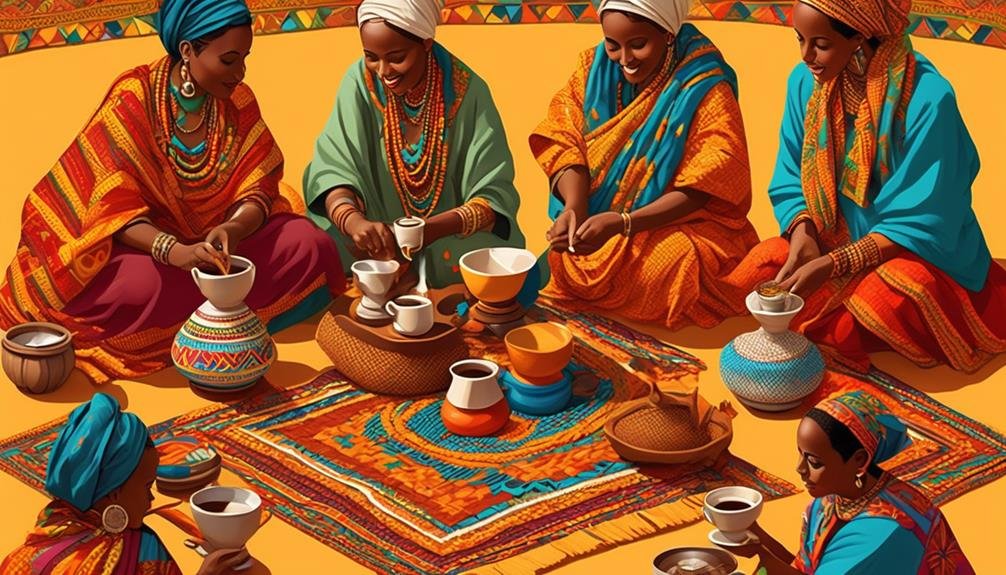In a world of globalization and interconnectedness, where cultures blend and boundaries blur, coffee stands as a testament to the power of regional traditions.
From the lush highlands of Ethiopia to the bustling streets of Italy, each corner of the globe has nurtured its own unique coffee culture.
But how exactly has coffee developed distinct regional traditions? What secrets lie behind the rich aromas and complex flavors that have captivated the world for centuries?
Step into the world of coffee and uncover the fascinating stories that have shaped its regional identities.
Key Takeaways
- Ethiopian coffee has a unique cultivation process and a traditional coffee ceremony.
- Italian espresso is meticulously crafted from carefully selected coffee beans and is the base for other popular coffee drinks.
- Turkish coffee is deeply ingrained in Turkish culture and has a meticulous preparation process.
- Colombian coffee stands out for its exceptional quality, unique flavors, and dedication of farmers and producers.
- Vietnamese coffee is known for its unique blend of Robusta beans and condensed milk, and is an integral part of Vietnamese culture.
Ethiopian Coffee: The Birthplace of Coffee Culture
Ethiopian coffee holds a pivotal role in the history and development of coffee culture, being the birthplace where the rich traditions and rituals surrounding this beloved beverage first took root. Ethiopia is widely recognized as the origin of coffee, with legends dating back to the 9th century.
Coffee production in Ethiopia follows a unique process that begins with the cultivation of coffee trees in small, family-owned plots. The cherries are handpicked when ripe and then go through a meticulous process of washing and drying.
The traditional Ethiopian coffee ceremony is a significant part of their culture and involves roasting the beans over an open flame and grinding them by hand. The freshly brewed coffee is served in small cups to enhance the tasting experience.
Ethiopian coffee is known for its distinct flavors, characterized by floral, fruity, and wine-like notes. The country’s diverse microclimates and indigenous coffee varieties contribute to this unique taste profile.
Ethiopian coffee has a strong influence on the global coffee industry, inspiring other countries to develop their own coffee traditions and rituals.
Italian Espresso: From Beans to the Perfect Shot
Italian espresso, renowned for its strong and concentrated flavor, is meticulously crafted from carefully selected coffee beans to deliver the perfect shot of pure caffeinated bliss. Here is a step-by-step guide to understanding the process behind creating this beloved beverage:
- Bean selection: Italian espresso starts with the careful selection of high-quality coffee beans. These beans are typically sourced from different regions around the world, such as Brazil, Colombia, or Ethiopia. Each batch of beans brings its own unique flavors and characteristics to the final blend.
- Roasting: Once the beans are selected, they undergo a precise roasting process. Italian espresso beans are typically roasted to a medium-dark to dark level, allowing the flavors to fully develop while still maintaining a rich, caramelized sweetness.
- Grinding and extraction: The final step in creating Italian espresso is the grinding and extraction process. The beans are finely ground to a consistency that resembles sand. This fine grind allows for optimal extraction of the flavors and oils during the brewing process. The finely ground coffee is then tightly packed into a portafilter, and hot water is forced through the grounds under high pressure, resulting in a concentrated and velvety smooth shot of espresso.
Italian espresso is a true art form, requiring skill, precision, and an understanding of the science behind extracting the perfect flavors from the beans. Whether enjoyed on its own or as the base for other popular coffee drinks like cappuccinos or lattes, Italian espresso continues to be a beloved tradition that brings people together over a cup of pure caffeinated delight.
Turkish Coffee: A Timeless Tradition of Preparation
Now let’s explore the timeless tradition of preparing Turkish coffee, a unique and cherished method of brewing that offers a rich and flavorful experience. Turkish coffee has been enjoyed for centuries and is deeply ingrained in Turkish culture.
The preparation process is meticulous and requires attention to detail. To make Turkish coffee, you’ll need finely ground coffee beans, preferably a dark roast, water, and sugar (optional). Start by measuring one cup of water for each serving and pour it into a small cezve, a special long-handled coffee pot. Add one heaping teaspoon of coffee per cup of water and, if desired, sugar to taste. Stir gently until the coffee and sugar dissolve.
Next comes the crucial step of heating the cezve over low heat, allowing the coffee to slowly simmer. It’s important to prevent the coffee from boiling, as this can affect the taste. As the coffee heats, a thick layer of foam will begin to form on top. Carefully remove the cezve from the heat and let it sit for a few moments, allowing the foam to settle.
Once the foam has settled, return the cezve to the heat and let it simmer again. Repeat this process two more times, ensuring the coffee is heated and the foam settles between each simmering. This process helps to enhance the flavor and give Turkish coffee its distinct character.
Colombian Coffee: From Bean to Cup in the Coffee Triangle
Colombian coffee, known for its exceptional quality and unique flavors, takes you on a journey from the lush coffee farms of the Coffee Triangle to the brewing process that brings out its rich aroma and distinct characteristics.
The Coffee Farms:
Picture yourself in the picturesque landscapes of the Coffee Triangle, surrounded by the vibrant green coffee plants that thrive in the region’s ideal climate and altitude. The farms stretch as far as the eye can see, with rows upon rows of coffee trees, each bearing bright red cherries ready to be harvested.
Hand-picking and Sorting:
Watch as skilled farmers meticulously hand-pick the ripe coffee cherries, ensuring that only the best ones are selected. These cherries are then sorted, separating the unripe or defective ones from the prime beans that will later undergo the transformation into a delightful brew.
Processing and Roasting:
Experience the intricate process of pulping, fermenting, washing, and drying the coffee beans. Witness the transformation of the beans from their raw state to the perfectly roasted ones, where they develop their distinct flavors and aromas. Each step is carefully monitored to bring out the best in every batch.
From the moment the coffee beans are picked to the final sip of the brewed cup, Colombian coffee embodies a tradition that showcases the dedication and craftsmanship of its farmers and producers. It’s no wonder that it has become a beloved choice for coffee enthusiasts around the world, delivering an unparalleled taste experience with every sip.
Vietnamese Coffee: A Unique Blend of Robusta and Condensed Milk
Vietnamese coffee, renowned for its distinctive taste and preparation method, combines the bold flavors of Robusta beans with the sweetness of condensed milk. This unique blend creates a harmonious balance of flavors that sets Vietnamese coffee apart from other varieties.
Robusta beans, which are native to Vietnam, are known for their robust and intense flavor profile. They’ve a higher caffeine content and a bolder taste compared to Arabica beans. This makes them perfect for creating a strong and flavorful cup of coffee.
The addition of condensed milk further enhances the taste by adding a creamy and sweet element to the beverage. The condensed milk is traditionally added to the coffee through a small metal filter called a Phin, which sits on top of a cup. Hot water is poured over the grounds, allowing the coffee to slowly drip into the cup. The result is a rich and velvety coffee with a hint of sweetness.
This unique blend of Robusta beans and condensed milk has become an integral part of Vietnamese culture and is enjoyed by locals and tourists alike. So, if you’re looking for a coffee experience like no other, be sure to try Vietnamese coffee.
Frequently Asked Questions
What Are the Health Benefits of Drinking Coffee?
Drinking coffee has numerous health benefits. It can boost your energy, improve your cognitive function, and even enhance your physical performance. Additionally, coffee is rich in antioxidants, which can protect against chronic diseases. So go ahead and enjoy that cup of joe!
How Can I Make an Authentic Ethiopian Coffee at Home?
To make an authentic Ethiopian coffee at home, start with freshly roasted Ethiopian coffee beans. Grind the beans to a medium coarseness and brew using a traditional Ethiopian coffee pot called a jebena. Enjoy the rich, aromatic flavors of this unique coffee preparation.
What Is the History of Coffee Cultivation in Colombia?
Colombia has a rich history of coffee cultivation, with the practice dating back to the 18th century. The country’s diverse climate and geography provide ideal conditions for growing high-quality beans, resulting in distinct regional traditions and flavors.
What Are the Different Types of Espresso Machines Used in Italy?
Espresso machines in Italy come in various types, each with its own unique features and functions. These machines, such as the manual lever machine and the automatic machine, play a crucial role in the rich coffee culture of Italy.
How Does the Preparation Method of Turkish Coffee Differ From Other Brewing Methods?
When discussing the preparation method of Turkish coffee, it is important to note how it differs from other brewing methods. Turkish coffee is unique in its finely ground beans and the use of a cezve, a small pot for boiling the coffee.
Conclusion
In conclusion, coffee has developed distinct regional traditions due to the unique cultural practices and preferences of different countries.
From the birthplace of coffee culture in Ethiopia to the perfect shot of Italian espresso, the timeless tradition of Turkish coffee, the coffee triangle in Colombia, and the unique blend of Robusta and condensed milk in Vietnamese coffee, each region has contributed its own distinct flavor and preparation methods to the world of coffee.
These regional traditions have helped shape the diverse and rich coffee culture that we enjoy today.




